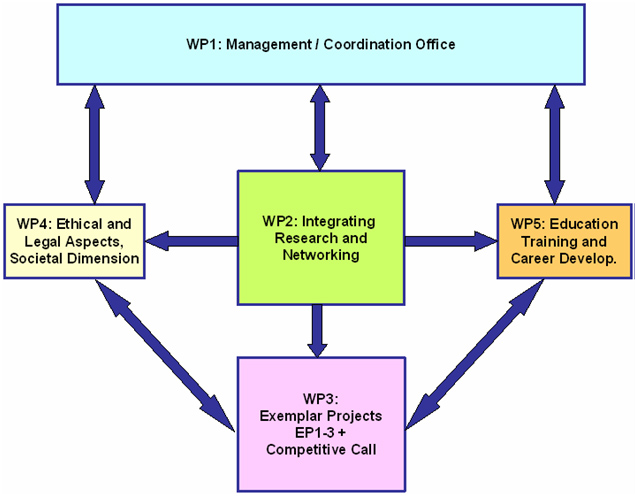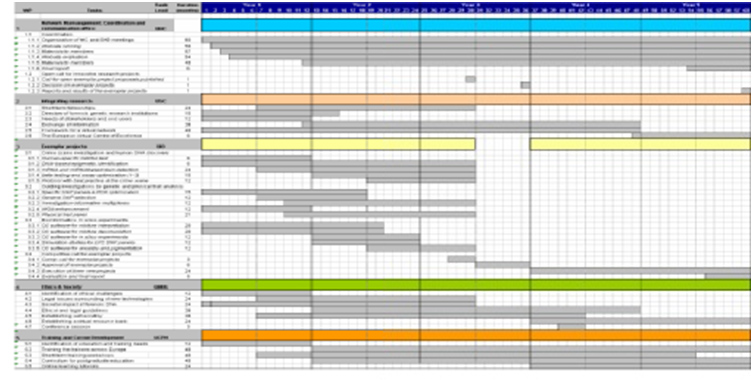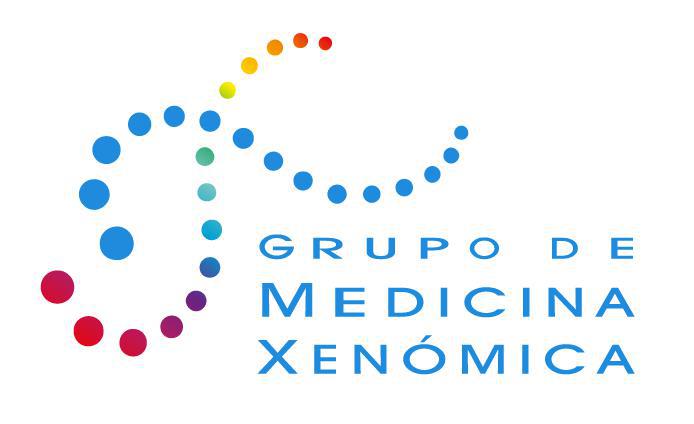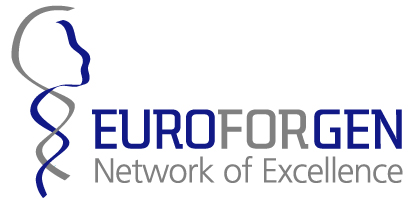EUROFORGEN-NoE Summer School: Working in a Forensic Genetics Laboratory

| Project coordinator (PC):Schneider, Peter M. (UHC) | Grant Agreement Nº:285487 | |
| Call: FP7 – SEC-2011.7.4-1 | Scheme: Network of Excellence | |
| Total budget: 6,613.681,00€ | Start date: 01/01/2013 | Term: 5 years |
| Web site: http://www.euroforgen.eu/ | ||
| Project summary: The main objective of the European Forensic Genetics Network of Excellence is the creation of a European Virtual Centre of Forensic Genetic Research. The Centre aims to evolve into a European-wide platform for the coordination and promotion of research and training activities, as well as for the public dissemination of results of high profile research. The network project is executed during five years between 2012 and 2016. It will help to establish stable collaborative structures to facilitate the exchange of information between research institutions, stakeholders and endusers, as well as to disseminate the network activities to the public, and to ensure long-term sustainability in this young discipline field of forensic science.
Key Words: Forensic genetics research, innovative field, applied science, virtual network, collaborative platform/ structure(s), training and education, DNA databases, predictive methods,crime, citizens/ society’s security. |
||
LIST OF BENEFICIARIES
| Partner | Name | Acronym | Type/ Category |
| 1 | Institute of Legal Medicine,
Klinikum – University of Cologne (DE) |
UHC | Public/ healthcare & research |
| 2 | University of Santiago de Compostela (ES) | USC | Public/ higher education & research |
| 3 | Institute of Legal Medicine,
University of Oslo (NO) |
NIPH/
UIO |
Public/ higher education & research |
| 4 | Section of Forensic Genetics, Department of Legal Medicine, Faculty of Life Sciences,
University of Copenhagen(DK) |
UCPH | Public/ higher education & research |
| 5 | Netherlands Forensic Institute, The Hague (NL) | NFI | Public/ higher education & research |
| 6 | Institute of Legal Medicine ,
Medizinische Universität Innsbruck (AT) |
IMU | Public/higher education & research |
| 7 | Norwegian University of Life Sciences (NO) | UMB | Public/ higher education& research |
| 8 | Institute of Forensic Research,
Jagellonian University(PL) |
IFR/ UJ | Public/ higher education & reseach |
| 9 | University of Northumbria (UK) | UNN | Public/ higher education & reseach |
| 10 | Epiontis GmbH, Berlin(DE) | EPTS | Private/ research |
| 11 | GABO :milliarium mbH&KG, Munich (DE) | GABO:mi | Private/ IT consulting |
| 12 | King’s College, London (UK) | KCL | Public/ higher education & research |
TEAM (*)
| Surname | Name | Title/ Position | Entity |
| Schneider | Peter M. | Department Head,
Prof of Molecular Genetics / PC |
UCH |
| Carracedo Álvarez | Angel | Department Head,
Professor, MD, PhD/ PI |
USC |
| Guillén | Margarita | Doctor in Law and judge | SpanishJustice administration |
| Lareu Huidobro | Mª Victoria | Prof of Legal Medicine, PhD | (CEGEN) USC |
| Phillips | Christopher | Sr. Researcher, PhD, SNP typing program | USC |
| Salas | Antonio | Ass. Prof., Population Genetics | USC |
| Sánchez-Diz | Paula | Sr. Researcher, PhD | USC |
| Brión | María | Sr. Researcher, PhD | USC |
| Gill | Peter | Prof. of Forensic Genetics,MD, PhD/ PI | UIO |
| Snydercombe Court | Denise | Reader in Forensic Science,
FIBMS, CSci, DMedT, MSB, CBiol, MFSSoc/ PI |
KCL |
| Morling | Niels | Dir. Of Forensic Medicine, MD, DMSc/ PI | UCPH |
| Klossterman | Ate D. | Prof. of Forensic Biology, PhD / PI | NFI |
| Sijen | Titia | Department Coordinator, PhD / PI | NFI |
| Parson | Walther | Ass. Prof. of Legal Medicine,
Forensic Molecular Biology Supervisor, PhD/ PI |
IMU |
| Egeland | Thore | Head of Biostatistics Group, PhD/ PI | UMB |
| Branicki | Wojciech | Ass. Prof., MD, PhD/ PI | IFR |
| Williams | Robin | Prof. of Forensic Science, PhD/ PI | UNN |
| Olek | Sven | CEO of Epiontis, PhD/ PI | EPTS |
| Schuster | Dieter | Founder & Director/ Sr Adviser | GABO:mi |
| Fuchs | Birgit | Managing Director,
Head of Research Services/ PI |
GABO:mi |
(*) For the sake of conciseness, only members of “Xenómica – USC” andPIs from the different entities involved have been listed.PC: Project Coordinator PI: Principal Investigator
Background to the project.
Forensic genetics is a highly innovative field of applied science with important relevance for the security of citizens. At the same time, the genetic methods to identify offenders as well as the creation of national DNA databases have caused concerns about possible violations of privacy and citizen rights. In this context, studies to assess the societal dimension of security following the implementation of even more intrusive methods such as the genetic prediction of externally visible characteristics are particularly relevant for their public acceptance. The network represents academic and public institutions, as well as SME’s, and includes 12 partners among them some of the leading groups in European forensic genetic research. It aims to create a closer integration of existing collaborations, as well as establishing new interactions in the field of security, as all key players are addressed: scientists, stakeholders, end-users, educational centres and scientific societies. Only if a long-term collaborative network can be established it will become possible to connect all scientific groups active in this field, and to initiate a sustained effort covering all aspects of research. These efforts have to be combined with identifying and selecting the most innovative ideas to meet the challenges of analyzing biological samples recovered from crime scenes and suspects to help with the identification of perpetrators and victims.
Objectives and main challenges.
The EUROFORGEN-NoE proposal fully addresses the topic description of the FP7 call:
SEC-2011.7.4-1
«Networking of researchers for a high level multi-organisational and cross-border collaboration»
Forensic genetics is an ideal field to create such a network since it is a mature science with the needsdescribes in the proposal. It addresses the societal dimension of security related to the use of DNA profilingand databasing. This network comprises a significant number of the leading groups in Europe on forensicgenetic research and proposes an integration of existing cooperations, as well as establishing new ones, inthis security field by integrating all the relevant parties (research centres, decision makers, stakeholders, endusers).This process will start around specific technical projects and aims to achieve a long lastingcooperation based on a joint programme of work leading to the emergence of a virtual research centre inthe security domain. An advisory board with highly recognized experts from the fields of ethical, legal,and forensic sciences ensures that the challenges defined in the network programme will be met.
| Challenge | Specific Objectives | Approach | |
| 1 | Tools for coordination of research in Forensic Genetics in Europe | Coordination of the activities | Coordination office
EUROFORGEN website |
| 2 | Long term stable collaborative networkstructures | Identification of challenges and needs.
To facilitate the exchange of informationbetween research institutions, stakeholders and end-users Long term sustainability |
Integration of efforts
Roadmap towards the creation of VirtualCentre of Research Approach stakeholders and decision makers for support |
| 3 | Integrating projects: Projects from different groups in Europe joiningefforts | Integrative and multidisciplinary projects contributing to the solution of practical casework projects | Exemplar projects among the members of the consortium
Competitive call for projects from othergroups in Europe |
| 4 | Evaluation of the ethical, legal, socialissues of the new knowledge and use of genomics medicine technologies | Develop standards for the ethics of phenotype prediction from sequence variation | Actions in ethical management, ethicalguidelines, societal debate and training programs |
| 5 | Lack of educational resources, common specialization programs and accredited training | Develop efficient dissemination and training forums and actions | Organisation of training courses, professional dissemination programmes and workshops
Pilot postdoctoral programs |
Table 1
Using the EUROFORGEN website (EUROFORGEN.ORG, to be introduced), the consortium will provide aframework for exchange of expertise and data, not only between consortium members but with any otherEuropean centre working in forensic genetics. It will bring together the knowledge and resources centred on forensic genetics tools and education at a European level, and allow researchers, forensic practitioners, stakeholders or industry to interact with/or integrate in the network. This will allow the forensic genetics research community as a whole to contribute significantly to the improvement of forensic genetics research and expertise.
Work Plan.
EUROFORGEN-NoE integrates five working packages (WP), each one’s title indicating the high level purpose (HLO) for that particular WP.
WP 1 is devoted to management and coordination.
WP 2 leads the main thrust of activities aimed at the creation of the European Virtual Centre of Forensic Genetic Research.
WP 3 carries out three exemplar projects as models of collaboration and integration of cutting edge research:
(i) DNA discovery at the crime scene, and identification of the biological source of DNA evidence;
(ii) development of new genetic markers providing DNA-based intelligence about unidentified stain contributors;
(iii) software tools for the biostatistical interpretation of complex DNA-based evidence.
These exemplar projects will be complemented in the second phase by a competitive call for new research proposals to integrate three additional projects and the responsible scientific groups into the network.
In WP 4 the societal dimensions of security, as well as the ethical and legal aspects, will be investigated systematically. An interdisciplinary approach is taken to better understand the diversity of possible public concerns across Europe and to develop common standards for the ethics of phenotype prediction and protection of privacy in the context of public security that can better become more generally acceptable by the society.
WP 5 is devoted to education and training, due to the rapidly evolving technology and the concurrent need to keep experts and scientists working in this field up to date with these developments. These activitieswill be based on the newly developed genetic marker types, their practical application including the new technologies required, and, most importantly, understanding the employing of new interpretation tools in the field of biostatistics, to raise the competence of reporting officers and scientists working in this field.
To accomplish the objectives in the previous section the work plan shown in table 2was put in place:
| WP nr. | Title/ Name | Lead participant |
| WP1 | Project Management: Coordination and communication office | UHC (P1) |
| 1.1 | Project Management | |
| Task1 | Scientific project coordination and management | |
| T.2 | Project management and Controlling | |
| T.3 | Contractual management | |
| T.4 | Communication management | |
| T.5 | Resources management | |
| T.6 | Management of Dissemination of Results | |
| 1.2 | Competitive calls for research | |
| Task7 | Competitive call for research proposals | |
| WP2 | Integrating research and networking: towards the creation of an European Virtual Center of Research in Forensic Genetics | USC (P2) |
| Task1 | To establish a directory of forensic genetic research institutions across Europe | |
| T.2 | To identify the processes involved in handling and analyzing forensic genetic evidence from crime scene to court room, and to describe the relevance, the strengths and potential flaws of forensic genetic evidence with regard to the specific needs of stakeholders and end-users. | |
| T.3 | To facilitate the exchange of information between research institutions, stakeholders, decision makers, and end-users. | |
| T.4 | To integrate research needs and capacities into a virtual network for the coordination of research in forensic genetics – the European Virtual Centre of research in Forensic Genetics, to ensure a sustained effect after the end of network funding. | |
| WP3 | Exemplar research projects (EPs) | UIO (P3) |
| EP1 | Crime scene investigation and human DNA discovery | NFI & EPTS (P6, P11) |
| Task1 | Human-specific DNA test | |
| T.2 | DNA-based epigenetic identification of the human source tissue | |
| T.3 | Evaluating the potential of mRNA and miRNA for mobile scene-of-crime analysis | |
| T.4 | Developing protocols for best practice in crime scene investigation and evidence collection | |
| EP2 | Guiding investigations by genetic analysis of physical traits and tailored multiplex development | USC & IMU (P2, P7) |
| Task1 | ||
| T.1.1 | Selection of SNP sets for specific purposes | |
| T.1.2 | Development and optimization of small-scale multiplexes | |
| T.1.3 | Broadening and consolidation of current physical trait association studies | |
| Task 2 | SNP selection | |
| T.3 | Development of crime-investigation informative multiplexes | |
| T.4 | Enhancement of WGS to analyze reduced DNA quantities | |
| T.5 | Physical trait analysis | |
| EP3 | Bioinformatics in silico modelling and statistics | UMB & UIO (P8, P3);
NFI, IMU |
| Task1 | Analysis of prior art and actual status | |
| T.2 | Autosomal markers (SNP’s chips) | |
| T.3 | Y-chromosomal and mtDNA markersimplementation in anopen-source statistical package ‘R’ | |
| T.4 | In silico experiments: determination of robustness and efficiency of multiplexes (WP3/EP2) prior to implementation | |
| T.5 | Analysis of complex DNA profiles/ mixtures | |
| T.6 | Bioinformatics:to complement STRBase with an extension of ‘forensim’ to act as the platform for ‘open-source’ programs written in ‘R’. | |
| WP4 | Ethical and legal aspects, and the societal dimension of forensic genetics | KCL (P12) |
| Task1 | To identify social and ethical legal risks associated with the development of forensic genetics. | |
| T.2 | To research the current laws regarding DNA data basing across Europe and examine legal issues surrounding the introduction of new forensic technologies | |
| T.3 | To research the societal impact by investigating public concerns about forensic DNA typing, the impact of criminal DNA databases and privacy protection. | |
| T.4 | To elaborate ethical and legal guidelines and make recommendations for the future | |
| T.5 | To engage all members of the Consortium in a process of ethical and legal ‘self-scrutiny’ as an essential element in the design, execution and implementation of the network as a whole and of the exemplar research projects (WP 3) in particular. | |
| T.6 | To establish a virtual resource bank of information about current and emerging uses of forensic DNA profiling. | |
| T.7 | To organise an session on ‘ethical, legal and social issues’ in an international conference which will present the work of EUROFORGEN-NoE. | |
| WP5 | Education, Training and Career Development | UCPH (P5) |
| Task1 | To identify the education and training needs among forensic scientists, police investigators, and members of the legal profession. | |
| T.2 | To organize a series of special focus seminars in forensic genetics to «train the trainers» across Europe | |
| T.3 | To establish a system of short-term training workshops for continuing education of forensic scientists, police investigators, and members of the legal profession. | |
| T.4 | To develop a curriculum for postgraduate education of scientists specializing in forensic genetics. | |
| T.5 | To implement online tutorials for self-education on subjects with relevance to the forensic community. |
Table 2
The interdependencies between the different WPs is shown below:

Figure 1
A summary of staff effort,in months, is presented in table 3 below:
| Partner | WP1 | WP2 | WP3 | WP4 | WP5 | TOTAL |
| 1 UHC | 18 | 30 | 36 | 24 | 24 | 132 |
| 2 USC | 62 | 22 | 13 | 19 | 116 | |
| 3 UIO | 5 | 19 | 10 | 34 | ||
| 4 UCPH | 17 | 31 | 6 | 60 | 114 | |
| 5 NFI | 12 | 24 | 12 | 12 | 60 | |
| 6 IMU | 14 | 40 | 4 | 10 | 68 | |
| 7 UMB | 3 | 30 | 3 | 36 | ||
| 8 IFR | 11 | 32 | 8 | 17 | 66 | |
| 9 UNN | 6 | 5 | 50 | 12 | 73 | |
| 10 EPTS | 2 | 48 | 4 | 54 | ||
| 11 GABO | 40 | 14 | 54 | |||
| 12 KCL | 19 | 25 | 53 | 11 | 108 | |
| Total | 58 | 181 | 313 | 169 | 195 | 915 |
Table 3
Cronogram.
Timing, schedule and details of WPs for the EUROFORGEN project are shown in the Gantt chart below:

Current project status. Progress made so far.
The project is on- going and during the second 15 months period, the EUROFORGEN consortium has intensified its work in all areas of activity and it has been achieved both by further enhancing the collaborations within the consortium, as well as by increasingthe connections with the scientific community outside the consortium. Main results were obtained in the following areas:
- i) evolution of the consortium website into the website of the Virtual Centre of Forensic Genetic Research andintegration of new research groups into the consortium (WP1 +2);
- ii) completion of the main part of research workwithin the three exemplar projects (WP3);
iii) extension of the ongoing work to describe and analyse the frameworkand forces influencing the ethical and legal impact of forensic genetics in European societies (WP4);
iv)establishment of a forensic genetics training infrastructure (WP5).
The Consortium has achieved an unexpectedly good visibility in our field of interest as a result of very intensive dissemination activities: we have shown presence at major congresses and working group meetings, by introducing aregular newsletter, by introducing a Facebook group that has already more than 130 members, and by continuouslyexpanding the information content available on our website. It is evolving into the website of the «Virtual Institute ofResearch in Forensic Genetics” (see D2.4; table 4 below). A central activity was the publication of an open call for researchproposals (D1.5; table 4), to invite three new research partners, and a total of 17 proposals have been submitted. This is aclear sign of the tremendous interest in this area of research, as well as of the fact that a dramatic lack of publicfunding sources for research in forensic genetics does not offer many possibilities to submit proposals.
As documented in the WP3 deliverables, a long list of original research papers has been published, and more dataare in their final stage of analysis to be published in the very near future. Although this may be considered a delay inthe execution of the project, it is rather a sign of the tremendous success of our research work, as the available datawere so abundant that it was impossible to get these published in time. The adjustments in the work plan asdescribed in the last report allowed us to integrate new technologies such as «next generation» sequencing methods.
The software developments carried out within EP3 are among the most innovative tools developed in our fieldsupporting the analysis of challenging low template and mixed trace DNA samples in crime casework.
The WP4 research on the societal impact of forensic genetics stimulated all partners to make contributions. D4.3 waspostponed from the first period due to due technical reasons. Now the ‘Audit on DNA legislation in Europe’ has beencompleted, and, to our knowledge, is the most comprehensive survey of its kind. It will raise interest from allstakeholders including national governmental authorities. The second research report on European-wide publicconcerns related to the use forensic DNA analysis (D4.4) is another excellent example of ground-breakinginformation not yet available from any other sources.
Starting from the results of our educational survey (D5.2) we have identified «Biostatistical interpretation of DNAevidence» as the most important topic for advanced education. The workshop series «Train the Trainer» has beenintroduced (D.5.3) providing advanced education for colleagues from all over Europe. Two workshops have beencarried out already, and two more «satellite» workshops have already been organized at the national level in Spainand Italy. This kind of activities clearly demonstrates the need for education, and we will organize two more TTTworkshops in the next two years. The newly introduced «career development board» will develop an appropriatecurriculum that encompasses all relevant areas of knowledge for scientists and experts involved in forensic DNA analysis.
(*) Table 4 with ID of all the WP and deliverables referred toin this section:
| WP nr. | Title/ Name | Participants |
| WP1 | Project Management: Coordination and communication office | UHC (P1) |
| 1.1 | Project Management | |
| D1.3 | Dissemination plan | |
| D1.5 | Publication of competitive calls for research | |
| WP2 | Integrating research and networking: towards the creation of an
European Virtual Center of Research in Forensic Genetics |
USC (P2) |
| D2.4 | A state-of-the-art-description of handling biological evidence from crime scene to court room | |
| WP3 | Exemplarresearchprojects (EPs) | UIO (P3) |
| EP1 | Crime scene investigation and human DNA discovery | NFI & EPTS (P6, P11) |
| EP2 | Guiding investigations by genetic analysis of physical traits and tailored multiplex development | USC & IMU (P2, P7) |
| EP3 | Bioinformatics in silico modelling and statistics | UMB & UIO (P8, P3);
NFI, IMU |
| WP4 | Ethical and legal aspects, and the societal dimension of forensic genetics | KCL (P12) |
| D4.3 | Report on legal audit of EU legislation on forensic DNAprofiling and databasing | |
| D4.4 | Appointment of a short-term research fellowship tocontribute to the work of the WP | |
| WP5 | Education, Training and Career Development | UCPH (P5) |
| D5.2 | White book on the current status of education andtraining in forensic genetics | |
| D5.3 | Kick-off meeting for «train the trainers» workshop series | |
| … |
Table 4
Expected final results and their potential impact and use(including socioeconomic and societal implications so far).
The EUROFORGEN-NoE efforts are leading to the establishment of the European Virtual Centre for Forensic Genetic Research. The centre will become the keystone for a long-term integration of research efforts at the European level. It will ensure a continuing and sustainable impact on the quality of science and forensic laboratory service to the benefit of the security sector in Europe. Through this centre it will become easy to identify and recruitexperts with special knowledge and technology to address specific scenarios with relevance to DNA-based geneticidentification, such as terrorism, disaster victim identification, organised crime, and other threats to the publicsecurity. After completion of 50% of the funding period the collaborative network structures have evolved into thestarting point of activities facilitating to connect all scientific groups active in the field of forensic genetics to achieve asustained effect covering all aspects of research. With the financial support from the current project numerousindividual and mostly altruistic initiatives and activities (past and current) aimed at improving the situation of forensicgenetic research are bundled into a common platform to jump-start a European-wide interaction of all relevantscientists.
With scientific working groups and societies such as the European DNA Profiling Group (EDNAP), the different language-based working groups of the International Society of Forensic Genetics (ISFG), as well as the DNA workinggroup of the European Network of Forensic Science Institutes (ENFSI), a close relationship has been established.
Numerous dissemination activities at meetings, workshops and congresses of the above mentioned groups were performed by consortium members increasing the awareness among fellow scientists, stake-holders and end usersabout the opportunities offered by EUROFORGEN-NoE.
The societal impact of forensic genetics and the potential for ethical or legal conflicts are major factors of the publicperception of forensic DNA typing. We have already observed that there is a high diversity among the Europeancountries regarding acceptance or critical awareness of these technologies in the public. We hope to raise the overallawareness of opportunities and challenges related to DNA profiling and to stimulate the public debate on theseissues. Competent resources and efficient strategies will be applied to the work carried out in the other workpackages in order to encourage an ongoing awareness amongst operational scientists and criminal investigators ofthe ethical and social pitfalls-issues that surround their work, and the importance of public trust for ensuring itssuccess. To this end, the Ethics Group within the consortium is aiming to build a base-line analysis of what aregenerally understood to be the major current issues in social, ethical and policy aspects of forensic genetics. Asystematic review in the form of a «Social and ethical risks report» will be used to inform the subsequent work of allcontributors to this work package. This work includes the analysis of legislative frameworks and other regulatorymechanisms for the governance of forensic genetics in the states of the European Union. It is envisaged that thedevelopment of ethical guidelines for research and deployment of forensic genetic technologies used in criminalinvestigations and prosecutions will have a major impact both on the scientific community as well as the generalpublic. The existing reports on Social, Ethical and Policy Aspects of Forensic Genetics, the Legal Audit, and onResearch into Public Concerns, as well as the ethical guidelines will all be made available on the Consortium WebSite and will also contribute to the education and training goals. We are confident that the currently achievedrecognition among scientist and stakeholders in the field can be expanded into the general public at the end of the funding period.
Derived publications. Communication – dissemination activities.
N/A






